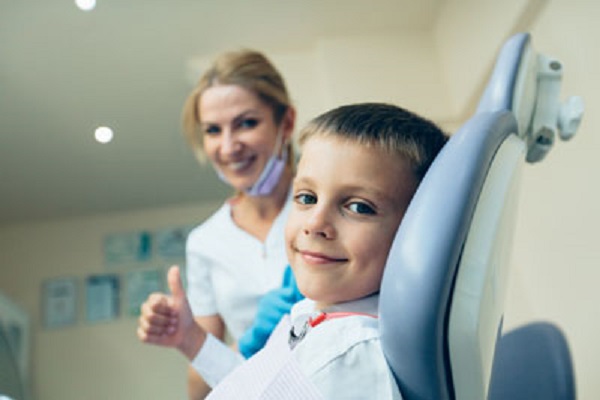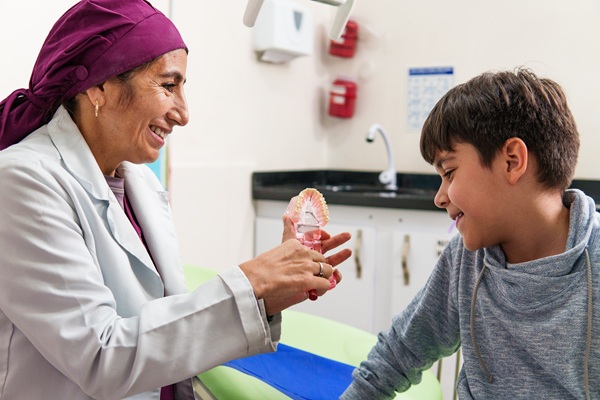From A Kid Friendly Dentist: Why It Is Important for Retained Primary Teeth To Be Extracted

A kid friendly dentist with a specialization in pediatric dentistry typically advises against pulling baby teeth. However, there are times where a dental extraction is required. This can seem counterintuitive, especially when losing baby teeth naturally is such a part of culture and childhood development. The loss of these primary teeth is often a bridge into the world of a child’s imagination, full of fairies and wonder. As magical as those childhood moments can be, though, it is more important for a child to develop a healthy and strong smile.
Importance of baby teeth
While baby teeth may seem like little more than placeholders for the eventual development of adult teeth, these primary formations are important. Primary teeth come in at a time when a child is in the midst of developing fundamental skills like chewing and speaking. Without these baby teeth, children might develop lisps or other speech impediments. These teeth also do stand as placeholders for adult teeth, but sometimes they might hinder that growth.
When tooth extractions are necessary
Most pediatric dentists want to avoid removing primary teeth, especially early in development. However, there are a few problems that may warrant premature extraction:
- Injury or trauma
- Crowding of adult teeth
- Decay
If a child must undergo a primary tooth extraction, then a kid friendly dentist will do everything in their power to make the procedure as comfortable as possible. Pediatric dentists achieve their specialization through extended schooling, which typically includes a focus on child psychology. Therefore, parents of children undergoing an extraction should rest assured that the procedure is commonplace and the dentist is well-trained for child interactions.
Basics of the procedure
While a little anxiety is understandable, tooth extractions on minors are not as involved as those performed on adults. Most procedures start with an X-ray to determine the bone and root condition of the tooth. Then, the dentist applies a local anesthetic and begins gently removing the tooth with forceps by rotating and moving it in the socket. The movement helps to separate the tooth from the periodontal ligaments that hold it to the jaw bone. In extreme circumstances, a child may be sedated to allow for the removal of some gum tissue.
Follow-up care
After the procedure, the dentist applies sterile gauze and possibly a few stitches to help the area heal. It is important to remember that some bleeding after an extraction is standard and that the area should be allowed to clot. Clotting protects against dry socket, a painful condition where the bone is exposed to air, liquids and food. To ensure adequate clotting, most dentists suggest that patients avoid rinsing for 24 hours, after which the patient can rinse with salt water to prevent infection and reduce pain. Also, a child should stick to only soft foods for the first few days and drink plenty of water.
Conclusion
Primary teeth are an essential part of early development, but these teeth can become problematic. For prevention of future issues, a child should see a kid friendly dentist once every six months.
Request an appointment here: https://www.grandparkwaypediatricdental.com or call Grand Parkway Pediatric Dental at (832) 579-0960 for an appointment in our Richmond office.
Check out what others are saying about our services on Yelp: Read our Yelp reviews.
Recent Posts
Ensuring a child has a strong foundation for lifelong oral health begins with finding the right pediatric dentist who understands the unique needs of children. A positive dental experience in childhood helps build trust and encourages good habits. However, with all the options available, it is important to know what factors to consider when starting…
Pediatric dentists often use tooth-colored composite fillings to repair cavities and damaged teeth. The combination of plastic resin and glass particles can last for years with proper care. They are a great option for those who want a natural-looking dental restoration for their children. This article will cover the process of recommending composite fillings for…
Cavities can happen to anyone, but they are especially prevalent in children. However, composite fillings restore their primary and secondary teeth without sacrificing appearance. Composite resin, or tooth-colored fillings, allows children to receive the necessary repairs without using unattractive metals that parents may remember from their childhoods. Many pediatric dentists now use this approach for…
If your child has cavities caused by tooth decay, composite fillings can fill the hole, protect their teeth, and restore their smile. Many parents prefer this option for their kids because it has a more natural appearance and does not create an eyesore. Others prefer them because they do not contain the same ingredients as…


